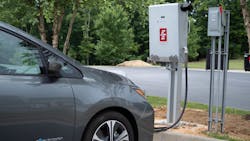California’s Bidirectional Charging Mandate Would Create Microgrids on Wheels & Turbocharge Resiliency
California has proposed requiring all electric vehicles (EVs) to be equipped with bidirectional charging beginning in model year 2030 – a move that would create microgrids on wheels that could support the grid, cut the need for fossil-fired peaker plants, reduce air pollution and provide resilience to disadvantaged communities during outages.
The California Assembly Energy Committee approved the bill July 12. During that same week, a heat wave in California prompted utilities to email customers encouraging them to purchase fossil-fuel backup generators, said Kurt Johnson, director of community energy resilience for the Climate Center, which sponsored the bill, SB 233.
Peter Asmus, executive director of the Alaska Microgrid Group, a nonprofit that designs and builds microgrid projects in Alaska, said he’s cautiously optimistic the bill will pass. If it makes it to Gov. Gavin Newsom’s desk, Newsom will likely sign it because he has supported many climate initiatives, Asmus said.
Bidirectional charging is in its infancy in the U.S. The best known example of this technology is the Ford F-150 Lightning. Drivers have boasted on social media that these electric trucks – which are sold equipped with bidirectional charging – have kept the lights on in their homes during power outages.
To use the technology, EV drivers need to purchase bidirectional chargers that can both charge the car and discharge the energy in the car’s battery to homes, buildings or the grid. Only a few bidirectional chargers are available right now, including chargers from Fermata Energy and Dcbel.
Bidirectional EVs as distributed energy resources
As electrification efforts continue – especially with the deployment of more EVs – the bidirectional EVs can supply clean energy to the grid when it’s needed. Failing to take advantage of the growing number of EVs as clean distributed energy resources would be a lost opportunity, Asmus said.
In addition, bidirectional EVs, serving as mobile microgrids, can be driven to disadvantaged communities – where residents can’t afford solar, storage and microgrids – to provide resilience during outages. They could also be driven to communities experiencing weather-related outages. In addition, the EV batteries could be aggregated to create a virtual power plant.
Such applications reduce dependence on fossil-fueled peaker plants and cut greenhouse gas emissions.
The “most important bill” in California
“I think this is the most important bill of the year in California,” said Asmus. “As California goes, so does the nation.” When California created refrigeration standards, manufacturers didn’t want to create a refrigerator for California and one for other states. So they focused on producing refrigerators for the entire U.S. that met California’s standards, he said.
“SB 233 is the most important climate legislation in history,” added John Sarter, Dcbel West Coast smart home integration partner. “The bill will enable all electric vehicles to become renewable energy partners to the grid, rather than a strain upon it. This enables a continually expanding excess capacity to be utilized by the grid for peak energy demands,” he said.
SB 233 was introduced by California Sen. Nancy Skinner, D-Oakland, and directs the California Energy Commission (CEC) and California Air Resources Board (CARB), working with the California Public Utilities Commission, to clarify, by December 2024, the definition of bidirectional-capable EVs to help the industry move toward the requirement of the bill.
According to the Climate Center, the bill also:
- Requires that by model year 2030, all EVs sold in California are bidirectional capable, except EVs exempt as determined by CARB.
- Directs the CEC and CARB to revise existing incentives for EVs to provide higher incentive levels for bidirectional-capable EVs and EV equipment, focusing first on investments in disadvantaged communities.
- Directs the CEC, in consultation with CARB, to establish state vehicle-to-home, vehicle-to-building and vehicle-to-grid goals to support emergency backup, electrical grid reliability and electric vehicle grid integration goals.
A small percentage of bidirectional EVs could do a big job
California has about 1.5 million EVs on the road and expects an estimated 8 million by 2030. If the state’s EVs become bidirectional, it would only take a small percentage of the 8 million to provide enough power to help avoid blackouts and create a more resilient grid. This would create cleaner air because renewable energy stored in EV batteries could be released during periods of high demand, said Johnson.
“I do think EVs are the distributed energy resources of the future,” said Asmus. “This also means we’ll need more microgrids. With more and more EVs, we’ll need a resilient grid to support EV charging.”
In addition, bidirectional EVs can serve as resources for microgrids, he said.
From a grid planning perspective, bidirectional EVs are less expensive than paying for new power plants, said Johnson. A study by the Electric Power Research Institute found that utilities and ratepayers could save $1 billion a year with vehicle-to-grid technologies.
Pacific Gas & Electric (PG&E), which implements public safety power shutoffs during fire season in its territory, hasn’t taken a position on the bill, said Mike Gazda, spokesman for PG&E.
“PG&E supports the expansion of vehicle-to-grid technologies, such as bidirectional charging, and has a company goal of enabling 2 million electric vehicles in its service territory to participate in vehicle-grid integration applications by 2030,” he said.
PG&E is one of many utilities presenting on important grid transformation issues at T&D World Live
Sept. 12-14 in Sacramento: Learn more here
Grid Transformation for an Electrified World
Tiptoeing into bidirectional charging
A few utilities and organizations are giving bidirectional charging a test run.
PG&E’s vehicle-to-everything pilot provides incentives for people to try vehicle-to-home, vehicle-to-commercial property and vehicle-to-microgrid charging.
The Alliance Center, a Denver, Colorado, nonprofit that models innovative green building technologies, is installing a Fermata Energy bidirectional charger with demand-peak predictive software to reduce energy costs while tackling climate change.
EVs can become part of the shared economy
Fermata Energy is one of the first companies to develop bidirectional charging technology. And Dcbel, recently received Underwriters Laboratories’ approval of its bidirectional charger. The Dcbel R16 is a solar inverter combined with a two-port bidirectional EV charger, said Sarter. It can manage all home energy, including a stationary battery, and export to the grid. And Emporia Energy plans to release in 2024 a bidirectional charger.
And Tesla, known for being an opponent of bidirectional charging, has said it will release an EV with the capability in two years.
Bidirectional EV technology takes advantage of assets that sit idle 90% of the time. Owners of EVs with this technology may soon join Airbnb renters and Uber drivers who also make use of assets sitting idle – at home or in a garage.
“I think that’s the wave of the future, and this fits into more of a shared economy,” said Asmus.








